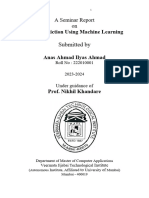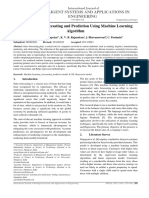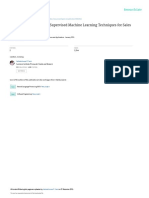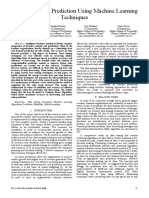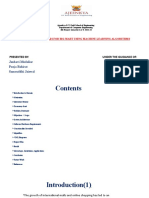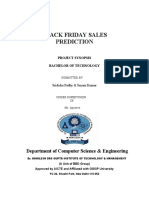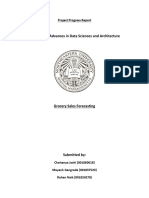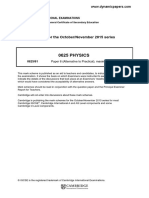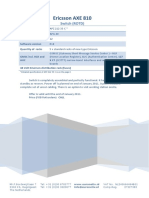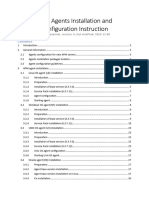ACKNOWLEDGEMENT
We are grateful to our respected guide Mr. Bhushan A. Deshpande for his kind,
disciplined and invaluable guidance which inspired me to solve all the difficulties
that came across during completion of project.
We express our special thanks to Dr. Vilas P. Mahatme, Head of the Department, for
his kind support, valuable suggestion and allowing me to use all facilities that are
available in the department.
Our sincere thanks are due to Dr. Avinash N. Shrikhande, Principal, for extending
all the possible help and allowing us to use all resources that are available in the
institute.
We are also thankful to our Parent and friends for their valuable corporation and
standing with us in all difficult conditions.
Project-mates
i
� ABSTARCT
Today’s dynamic retail landscape, accurate sales forecasting has become a crucial
aspect of effective inventory management, financial planning, and strategic decision-
making. Retailers are increasingly relying on predictive models to anticipate future
sales trends, helping them optimize their operations and better meet customer
demands. This project proposes a machine learning-based forecasting model designed
to predict retail sales with precision. By analyzing historical sales data, the system can
identify patterns and trends, allowing it to forecast future sales accurately. The model
incorporates several key factors, such as promotional activities, seasonal variations,
and economic indicators, to enhance its predictive capabilities, providing a robust tool
for retailers to streamline their processes and improve profitability.
To develop this predictive model, various machine learning techniques were explored,
including linear regression, decision trees, and neural networks. Each method was
evaluated for its ability to analyze historical sales data and produce accurate sales
forecasts. The project tested these techniques by using sales data that included factors
such as price, discounts, and promotional efforts. The analysis revealed that machine
learning models could significantly outperform traditional forecasting methods by
uncovering hidden patterns and relationships in the data. As a result, retailers can
more effectively anticipate demand, adjust their inventory levels, and optimize pricing
strategies to align with market trends and consumer behavior.
This project leveraged advanced tools and technologies such as Python, scikit-learn,
and TensorFlow for model building and evaluation. The system was designed to be
scalable, enabling it to process large datasets and adapt to various retail environments.
The machine learning models developed were tested against traditional forecasting
approaches, and the results showed a substantial increase in forecasting accuracy. By
implementing this predictive model, retailers can improve resource allocation, such as
staffing and marketing, and enhance customer satisfaction by ensuring popular
products are available when needed. The conclusion drawn from the project is that
machine learning offers a powerful solution for retail sales forecasting, leading to
more informed, data-driven decisions and ultimately improving operational efficiency
and profitability.
KEYWORDS: predictive model for retail sales using machine learning, python, R, VS
code, analyzing market trends, machine learning techniques.
ii
� CONTENTS
Acknowledgement i
Abstract ii
Contents iii
Abbreviations vi
List of Figures vii
CHAPTER 1 INTRODUCTION 1-3
1.1 Preamble 1
1.2 Motivation 2
1.3 Aim 2
1.4 Objectives 2
1.5 Organization of Report 2
CHAPTER 2 PRIOR ART 4-6
2.1 Sales Prediction systems and methods 4
2.2 Predictive and profile sales
automation analytics system and method. 5
2.3 Predictive and profile sales automation analytics
system and method. 5
2.4 System for predicting sales lift and profit of a 6
product based on historical sales information.
iii
�CHAPTER 3 LITERATURE REVIEW 8-12
3.1 Predictive Model for Retail Sales using Machine 8
Learning
CHAPTER 4 PROPOSED APPROACH AND SYSTEM 13-25
ARCHITECTURE
4.1 Proposed approach 13
4.2 Exploratory Data Analysis 16
4.3 Machine learning 18
4.4 Linear Regression 20
4.5 Random forest Algorithm 22
4.6 sales prediction model 23
4.7 System architecture 25
CHAPTER 5 TOOLS AND TECHNOLOGIES 27-40
5.1 Python 27
30
5.2 R Language
33
5.3 Anaconda
34
5.4 VS Code
36
5.5 Streamlit
36
5.6 Jupyter Notebook
39
5.7 Pandas
CHAPTER 6 41-53
IMPLEMENTATION
6.1 Purpose 41
43
6.2 Dataset Description
44
6.3 Data preprocessing
6.4 Model selection 47
iv
� 50
6.5 Result
51
6.6 Deployment
CHAPTER 7 54-61
RESULTS AND DISCUSSION
54
7.1 Model Performance
55
7.2 Result interpretation
59
7.3 Feature Importance
60
7.4 Model Comparison
CHAPTER 8 62-64
CONCLUSIONS
62
8.1 Limitations of the study
63
8.2 Future Scope of Work
Reference 65-66
v
� ABBREVIATIONS
Abbreviations Descriptions
VS Code Visual Code
LSTM Long Short-Term Memory
RNN Recurrent Neural Network
ARIMA Auto Regressive Moving Average
DBSCAN Density-Based Spatial Clustering of Applications with
Noise
TF-IDF Term frequency-inverse document frequency
vi
� LIST OF FIGURES
Figure Title Page
4.1 Data collection and Data Preprocessing 14
4.2 Steps for Performing Exploratory Data Analysis 17
4.3 Machine Learning 19
4.4 Linear regression 22
4.5 Random Forest Algorithm 23
4.6 Sample of sales predictive model 24
4.7 Use case diagram of project 26
5.1 Attributes of R language 30
5.2 Vs Code IDE Interface 34
5.3 Jupyter notebook 38
5.4 Pandas features 39
6.1 Dataset sample 42
6.2 Heatmap 44
6.3 Distribution of sale 45
6.4 Actual Vs Predicted Sales 49
6.5 Residual Plot 50
6.6 Code for generate date range prediction 52
7.1 Homepage Interface 55
7.2 Choosing items screenshot 56
7.3 Output Generation 57
7.4 Total sales prediction 58
vii
�viii








